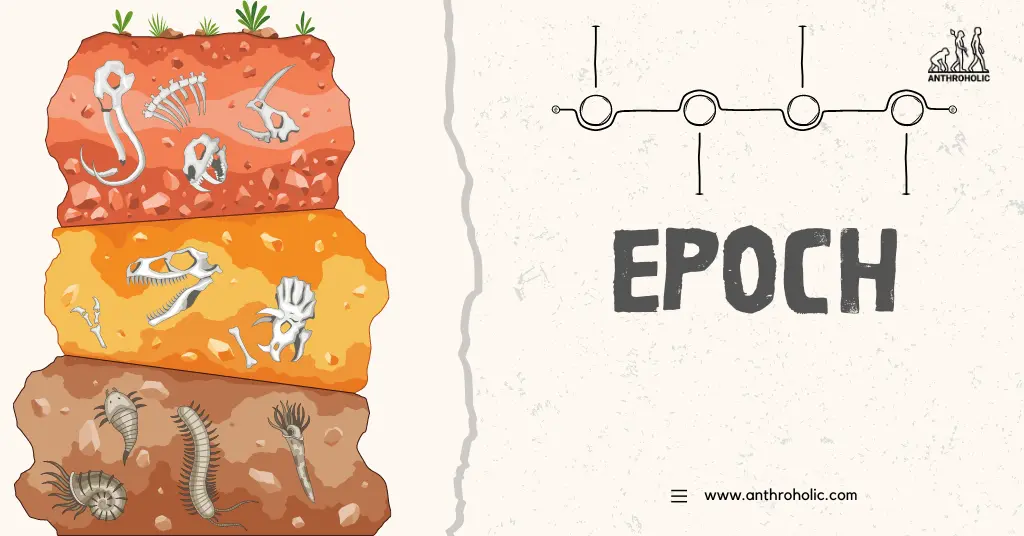AI Answer Evaluation Platform Live Now. Try Free Answer Evaluation Now
Epoch
The concept of an ‘epoch’ is pivotal in understanding the framework of geologic and astronomical time scales, acting as a vital tool for scientists in comprehending Earth’s extensive and complex history. The term ‘epoch’ refers to a distinctive period in the timeline of a distinct entity, such as the geological history of Earth or the universe’s cosmic history [1].

Definition and Classification of Epochs
An epoch is a unit of time that demarcates specific eras, with each epoch characterizing a unique stage in the timeline of the universe, planet, or any other entity. In geology, epochs are used to subdivide the eras of the geologic time scale into smaller segments to present a more detailed view of Earth’s history. On the other hand, in astronomical context, epochs refer to specific points in time that aid in tracking celestial bodies and predicting their positions [2].
Geological Epochs
Geological epochs form part of the larger geological time scale, which is divided into several units: eons, eras, periods, epochs, and ages. Eons represent the largest time scale, followed by eras, then periods, and epochs respectively. The smallest unit of the geological time scale is the age. The division into epochs helps provide a more granular understanding of Earth’s history. Each geological epoch corresponds to significant geological or paleontological events, such as mass extinctions or climatic shifts [3].
Astronomical Epochs
In the field of astronomy, an epoch does not necessarily refer to a span of time but instead to a specific point in time. This is used as a reference point to measure celestial coordinates. Astronomical epochs are denoted in years and are often used to track the motion of celestial bodies across time. The commonly used astronomical epochs are Julian epochs (starting from noon on January 1, 4713 BC, in the Julian calendar) and Besselian epochs (defined by the position of the Sun at the time of the Earth’s perihelion) [4].
| Classification | Description |
|---|---|
| Geological Epochs | A division of the geological time scale that corresponds to a specific span of time characterized by distinctive geological or paleontological events |
| Astronomical Epochs | A reference point in time used to measure celestial coordinates and track the motion of celestial bodies |
Notable Geological Epochs
To understand the concept of geological epochs, let’s delve into some examples:
- Pleistocene: Lasting from about 2.6 million to 11,700 years ago, the Pleistocene epoch was characterized by repeated glacial cycles where ice sheets advanced and retreated across the globe. It’s also known as the ‘Ice Age’ [5].
- Holocene: The Holocene epoch began at the end of the last Ice Age, around 11,700 years ago, and extends to the present day. It is marked by the advent of human civilization and significant climate stability [6].
- Anthropocene: While not yet officially recognized as a distinct geological epoch, the term ‘Anthropocene‘ has been proposed to represent the period of Earth’s history significantly impacted by human activities. It emphasizes the drastic environmental changes due to human influence, potentially starting from the Industrial Revolution [7].
Epochs and Technological Time Scale
While we’ve discussed epochs in the context of geological and astronomical time scales, it is worth noting that the term ‘epoch’ is not limited to these fields. In the world of information technology and computer science, ‘epoch time’ is a system for tracking time that represents time as the number of seconds that have passed since the ‘Unix Epoch’ – 00:00:00 Coordinated Universal Time (UTC) on Thursday, 1 January 1970 [8].
Unix Epoch Time
Unix Epoch time, also known as POSIX time or UNIX timestamp, has become a standard in various systems and technologies. Epoch time simplifies the storage and computation of dates and times as it represents them as a single, continuously increasing number. This is particularly useful in fields where precise time tracking is essential, such as in scheduling systems or databases.
| Classification | Description |
|---|---|
| Unix Epoch Time | A system for tracking time that represents time as the number of seconds that have passed since 00:00:00 UTC on Thursday, 1 January 1970 |
The Role of Epochs in Machine Learning
In machine learning, an ‘epoch’ takes on yet another definition. Here, an epoch refers to one complete pass through the entire training dataset by the learning algorithm. The number of epochs is a hyperparameter that defines the number times the learning algorithm will work through the entire training dataset [9].
Training Epochs in Machine Learning
- Single Epoch: In a single epoch, each example in the training dataset has had an opportunity to update the internal model parameters.
- Multiple Epochs: Running for more epochs, like tens or hundreds, means that the learning algorithm has many opportunities to learn from the dataset, but also, after a point, may result in the model learning too well and forming an overfitting model.
| Classification | Description |
|---|---|
| Single Epoch | Each example in the training dataset has had an opportunity to update the internal model parameters |
| Multiple Epochs | The learning algorithm has many opportunities to learn from the dataset, potentially leading to overfitting if the number of epochs is excessive |
Conclusion
In summary, the concept of epochs plays a crucial role in our understanding of time scales, whether geological or astronomical. Epochs provide a granular view of the geological time scale, helping us appreciate the complexities of Earth’s geological history. Astronomically, epochs serve as fixed points in time, assisting scientists in tracking celestial objects accurately. As we continue to learn and expand our knowledge about our planet and the universe, the understanding and usage of epochs remain as instrumental as ever.
Suggested Articles
References
[1] Gradstein, F.M.; Ogg, J.G.; Smith, A.G. (2004). A Geologic Time Scale 2004. Cambridge University Press. https://www.researchgate.net/publication/344477833_A_Geologic_Time_Scale_2004_Cambridge_Univ_Press_589_pp
[2] Meeus, Jean (1998). Astronomical Algorithms. Willmann-Bell.
[3] Stanley, Steven M. (1999). Earth System History. W.H. Freeman and Company.
[4] Seidelmann, P. Kenneth (1992). Explanatory Supplement to the Astronomical Almanac. University Science Books.
[5] Richmond, G.M., and D.S. Fullerton (1986). “Pleistocene stratigraphy and chronology”. In: Quaternary Nonglacial Geology: Conterminous U.S. Geological Society of America. https://liberalarts.tamu.edu/csfa/wp-content/uploads/sites/14/2023/07/CRP-21-2004.pdf
[6] Walker, M., J. Johnsen, S. Rasmussen, T. Popp, J.-P. Steffensen, P. Gibbard, W. Hoek, J. Lowe, J. Andrews, S. Björck, L. Cwynar, K. Hughen, P. Kershaw, B. Kromer, T. Litt, D. Lowe, T. Nakagawa, R. Newnham, and J. Schwander. 2009. Formal definition and dating of the GSSP (Global Stratotype Section and Point) for the base of the Holocene using the Greenland NGRIP ice core, and selected auxiliary records. Journal of Quaternary Science, vol. 24, pp. 3-17. https://doi.org/10.1002/jqs.1227
[7] Steffen, W., Crutzen, P. J., & McNeill, J. R. (2007). The Anthropocene: Are Humans Now Overwhelming the Great Forces of Nature. Ambio, 36(8), 614–621.
[8] J. Corbet, A. Rubini, G. Kroah-Hartman, Linux Device Drivers (3rd Edition), O’Reilly Media, Inc., 2005.
[9] Goodfellow, I., Bengio, Y., Courville, A. (2016). Deep Learning. MIT Press.




